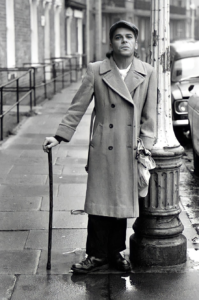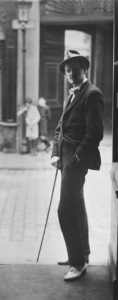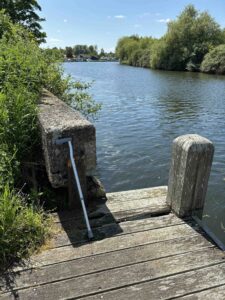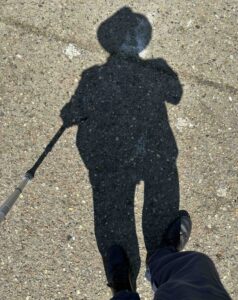In the 1960s, when I was five or six years old, in the polio ward at Mearnskirk Hospital, I was tested for the first time to see what the neuromuscular condition affecting my legs and walking was. This was a residential facility outside Glasgow. Mostly I remember the wee polio boys in iron lungs in a line, each with his own French window so he could be pushed into the therapeutic fresh air outside, daily when weather permitted. And watching Celtic on tv playing in the European Cup. The same tests—nerve conduction studies—electric currents shot through the nerves and measured for speed and efficiency, which could help determine your condition—were done when we’d moved to England, at Addenbrooke’s, Cambridge, aged 14 or so.

By then it was the 1970s, and punk rock came along with surprisingly perfect timing. It was good for a boy who couldn’t walk properly, tripped up a lot, often spectacularly, and had, as my teachers in different English schools confirmed, ‘an attitude problem.’ Was there a connection? It didn’t really occur to me at the time. But seeing Ian Dury live when I was 16 began to put some questions and answers in my head: ‘HALLO TO YOV OVT THERE IN NORMAL LAND / WE TOO ARE DETERMINED TO BE FREE.’
So, as a result of these tests as a youngster, in major national hospitals in each country, when I was 40 there was great puzzlement among the neuro consultants I was now being referred to more regularly that I’d never been definitively diagnosed. My records were lost, so they gave me … nerve conduction studies. They seemed to be more painful than I’d remembered from childhood, or maybe older nerves just get more frazzled. (Nowadays genetic testing is used in diagnosis too.)
When I was finally diagnosed after that it was with Charcot Marie Tooth disease, one of the most common inherited neurological conditions, that results in peripheral neuropathies. (I’m CMT type 1-A, in case you know these things.) The neuropathies generally present physically in the form of weakened muscles in lower limbs and forearms. You can’t walk properly, you trip up a lot, you slow down, you lose your sense of balance, you fall over a lot, standing needs sitting, your hands weaken, handwriting goes, dexterity is diminished, buttoned shirts become a thing of the past, you begin to buy shoes by weight, you can’t do your wriggling baby’s nappy up, you stop going to festivals—uneven fields! In the dark!—and live gigs where it’s standing only. Outside the summer months your feet, legs and hands are numb, and even freezing: numb’s pain. You might develop back or hip problems (I have scoliosis). Sleep and tiredness become new problems. There’s (still) no treatment, and it slowly gets worse. But, on the plus side, CMT doesn’t kill you.
On the day of my diagnosis, twenty-odd years ago, aged 40-ish, I was standing in the car park at Preston Royal Infirmary. More accurately, I was leaning against the car. I was trying not to cry, and failing. I was overwhelmed by the confirmation that I had a chronic condition that was changing my life (somehow ‘life-changing’ sounds worse), and it seemed inescapably serious. These emotions were magnified by the fact that I was a father of two young children. (One’s immediate thoughts: 1. how can I look after my daughters if I can’t even carry them without risk of falling over? 2. Have I given CMT to them?)
But I was also relieved by the diagnosis because, frankly, it could all have been worse. A number of other neurological conditions were in the frame prior to the results being clear, and CMT was at the lower end of seriousness of all the options. I was determined to present this—to my family, to myself even—as good news, because it seemed like it was the least bad news.

On that day, I went through some of the future options for me. I powerfully remember saying to myself—in my head, my imbalanced head—if I can get to aged 50 before I need a walking stick I will settle for that right now. (I wonder if I was determined to think of a stick rather than a chair.) In this scene in my mind, at 50 I would be like … James Joyce, who used in life and on page a cane—Stephen Daedalus’s ‘ashplant’. This target, I suppose it was, seemed to fit with my immediate post-diagnosis effort at modest optimism in that Preston car park. I was setting it a decade or so into my now clearer future, when my children would be teens, and I, who knows, might have matured into possessing a stable degree of acceptance and adaptation around my health.
Last week I had an hour with a warm and sympathetic health professional in the physio department of my local community hospital in Norwich. I was discussing and being measured up for the use of a walking stick. The day may have come. But I’m not 50 years old, I’m 63. And a half. On the day, the physio gave me my own walking stick. (Actually she also said, ‘Hmm, I think in your condition you should use two,’ but let’s not spoil the story. Plus I don’t feel ready for that yet.)
It came from the store cupboard, into which I had a peek. It was full of mobility devices, stacked up and on shelves, each wrapped in clear plastic with an NHS bar code, from frames and rollators to crutches and elbow ones that have a gutter for your entire forearm. Some sticks have four feet for super-enhanced stability. One is called the ‘HurryCane’, surely ironic, possibly in bad taste. My future is in that cupboard. My stick is a starter model. It’s an aluminium thing with a thick grey plastic finger-moulded right-angled handle (good for my CMT-weakened grip). The height is adjustable by popping a metal pusher into one of several holes. The rubber ferrule at its foot is wide and solid at its base.
Perhaps I looked apprehensive as I contemplated this new stage in my ‘care journey’, and glimpsed subsequent stages back in the cupboard for, having measured me up, my physio said gently, ‘Try walking along the corridor using the stick. I’ll be beside you.’
So, to now. Today, a warm if breezy early summer day, I drove to one of Norfolk’s many casually magic spots, at a confluence of three rivers, the Tas, Wensum, and Yare. I thought I might need a little bit of extra power, gift of the genius loci (I am smiling as I write that, but I also mean it), for my practical experiment. There’s a café, level metalled waterside walkways, and a relatively recently created pair of broads (small lakes). I went to the café first, had tea and a vegan sausage roll, and carrot cake. Then I went back to my car and got my walking stick, with the aim of practising using it properly, in everyday public life, for the first time.
I tried to remember my physio’s advice from the corridor: don’t let it wave around in the air doing nothing, land it solidly on the ground in front of you with each step, enjoy the chance to look up and around you not down at the ground while walking, let it take the weight to steady your balance when standing still. With the misplaced confidence of the initiate I quickly added more guidance of my own: don’t get out of the way of others coming towards you but expect them to see your stick and make way for you. To my surprise, that worked. To my great surprise, it all kind of worked.
I probably assumed the stick would be a hindrance, a vertical hurdle, another too close material object to distrust, to negotiate, or functionally to trip me up even. After all, I had left it in my car on the first part of my day out, to the café. How would I hold my lunch tray and a stick, or extract a bank card for payment (a fiddly thing for me at the best of times) and hold a stick? So plainly I had reservations. But for the pure purpose of walking I hoped it might come into its own, even if I was undeniably ambivalent about this new unhideable stage in my life. I do understand that its unhideability is part of the point of the stick: a marker to prompt my accommodation by the TABs (temporarily able-bodieds).
In my everyday walking I have spent, hmm, yes, decades with my head half-down, my gaze on the ground just before me, scanning the terrain ahead, attentive to the potential obstacle. It could be a kerb, a slight dip in the ground, a tussock on the grass, a pothole, a hidden step, a floor level change, a slope or gradient shift. Endless trip and fall hazards to be identified and adjusted for, a constant added drain on the energy of the day. At night? More challenges, with no visual cues. Snow/ice? Best stay indoors really.
But today as I walked with the stick I quite quickly felt less vulnerable than normal, and it meant I was able to raise my gaze. I made myself look up at the world and around me at nature, not in glances and glimpses but in whole long takes. In the film of me today, I was doing dolly and pan shots. At one moment I turned my neck to look back while walking forward—unheard of territory!
It wasn’t even looking high up at the treetops that was special; it was more the moving hedges and shrubs at eye level that hit me, because this had become, I now realise, something of a lost middle zone for me, in terms of looking mainly down at the ground, occasionally up at the sky. My visual cityscape when pedestrian had become over the decades others’ legs. Yet eye level is the most stimulating field of visual perception when walking—all those faces, shop fronts, vehicles, bay windows. Could that visuality be mine again? I had no idea whatsoever that a stick might improve my … sight.
Even though I was grappling with the stick, and concentrating hard on how to hold it with my hand, move it through the air between steps, plant it squarely on the ground, avoid it with my inconsistent leg, I felt I was achieving something. I did develop a small muscle ache in my upper left arm just from using it. I took that to be a success symptom. While walking and looking up around me—simple, simple words—I saw schoolkids learning to paddleboard on the broad. Seems we were all working on our balance today. Because my back and neck were upright, chin out forward, I felt taller.

Also, I really didn’t anticipate the pleasure it could give me in merely … standing still. That physical act which many have never given a thought to, is both a difficult and a tiring one for me. It is a constant judgement of balance, requires endless adjustment and small moves of the feet, knees bent to lower the centre of gravity, in a silent concentrated war against a fall. I chose a spot on a jetty to look upstream at where two of the rivers meet, stuck my cane out at what I took to be a moderately jaunty angle, and leaned on it lightly. I looked into the water, up at the sky, over to the trees on the opposite bank, listened to the birds, felt the sun and the northerly wind on my face. Some minutes later, I realised I was still still.
Of course a man in his sixties using a walking stick outdoors is not a big deal. It is neither a revelatory nor a revolutionary narrative. Nor does it speak to the liberatory (or indeed diminished) possibilities of the identity or experiential politics of the disabled. And yet, it has revealed something to me about me, which may be literally and metaphorically the beginnings of a new path, if that’s not too much.
Also, sometimes revolutionary politics are micro-politics.
And, in recent times of what seems to me like government policy shamelessly/-fully targeting disabled people, when a disabled man feels somehow a bit more free—and, let’s acknowledge it all, is supported in that by a local authority care team, NHS physio, brilliant consultants at the National Hospital for Neurology, a personal neuro-muscular adviser from Addenbrooke’s (full circle!), a PIP award, a Blue Badge for parking, a set of reasonable adjustments agreed with my employer, and more—that is a kind of liberation through personal experience and political process alike. (This sentence was written before the change of government in the UK in July 2024. Update 2025: in a shocking or predictable move, the new Labour government immediately targeted … disabled people. Shameful.)

I understand that my sticked walk today, tentatively steady, head held almost high, and those short, intense periods of simply standing still while looking at the nature before me, is small-scale, low-level stuff. I am not claiming Caned and Able, nor the supposed glories of a techno-solution. I am not solved. It was casual. And I wasn’t in a crowd, say, where presumably one’s stick presents other challenges. But in the moment I felt a slightly different man to the one I was this time yesterday, and the difference was located in my relationship to the world, in my capacity both to be in it and to see it. I thought it would be a new hindrance, an all-too-visible marker of my physical diminution. Yet somehow it set rather than upset me. Walk with me, o stick, walk me.
